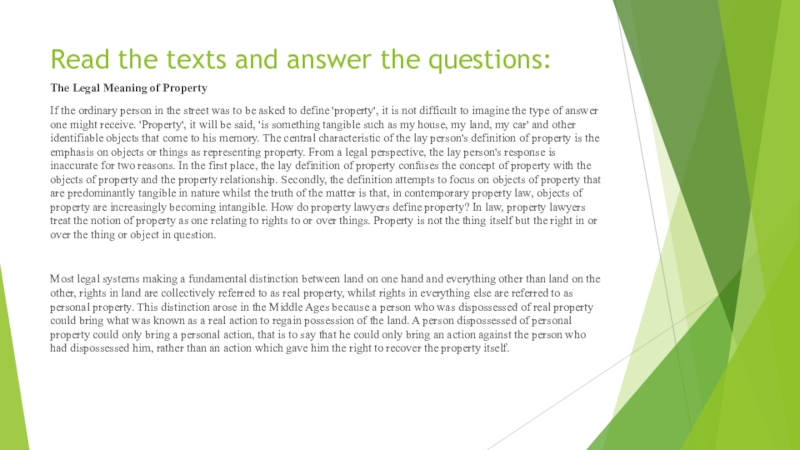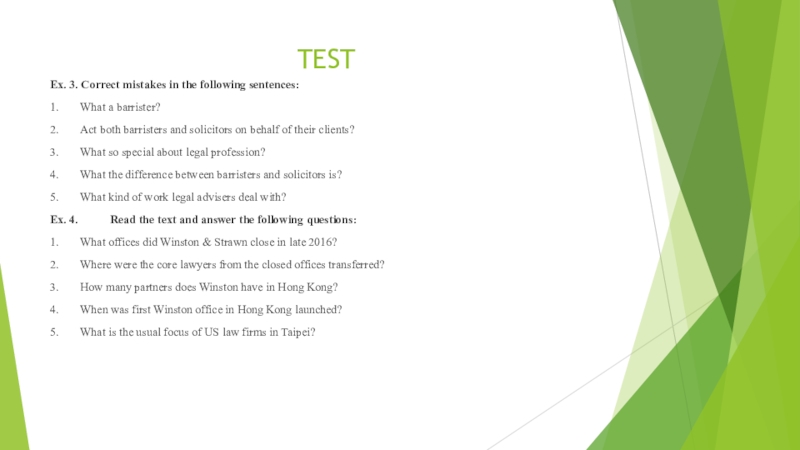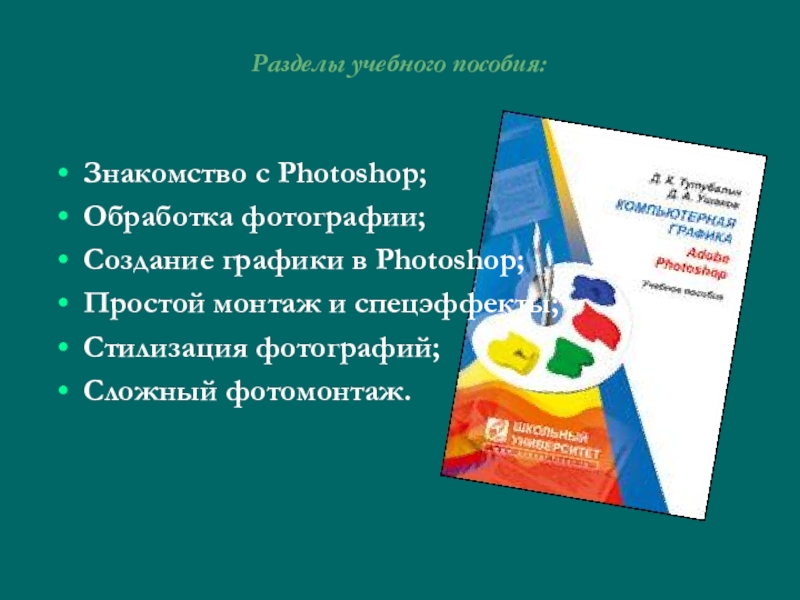Слайд 31. property - 1. собственность, право собственности;
2. объект права собственности, имущество
2. tangible property
(syn. corporeal) -материальная собственность
3. intangible property
(syn. incorporeal) -нематериальная собственность
4. lay person -обычный человек (без специального юридического образования)
5. distinction -различение, разграничение, отличительная особенность
6. to distinguish
(syn. to make distinction) -проводить различие, отличать
7. real property
(syn. real estate) -недвижимое имущество, недвижимость
8. personal property -личная собственность
9. deed -документ за печатью
10. conveyance -1. передача прав, имущества; 2. документ о передаче прав или имущества
11. deed of conveyance -акт о передаче правового титула, акт отчуждения
12. to dispossess of smth. -лишать чего-либо
13. possession -владение
14. to regain possession -возвращать владение
15. proprietary rights -права собственности
16. to be rooted in -уходить корнями в
17.to date back to (from) -вести начало (от чего-либо), восходить (к определенной эпохе)
18. immovable property -недвижимое имущество
19. movable property
(syn. movables, chattels) -движимое имущество
20. premises -зд. владения (земельные)

Слайд 4Read the texts and answer the questions:
The Legal Meaning of
Property
If the ordinary person in the street was to be
asked to define 'property', it is not difficult to imagine the type of answer one might receive. 'Property', it will be said, 'is something tangible such as my house, my land, my car' and other identifiable objects that come to his memory. The central characteristic of the lay person's definition of property is the emphasis on objects or things as representing property. From a legal perspective, the lay person's response is inaccurate for two reasons. In the first place, the lay definition of property confuses the concept of property with the objects of property and the property relationship. Secondly, the definition attempts to focus on objects of property that are predominantly tangible in nature whilst the truth of the matter is that, in contemporary property law, objects of property are increasingly becoming intangible. How do property lawyers define property? In law, property lawyers treat the notion of property as one relating to rights to or over things. Property is not the thing itself but the right in or over the thing or object in question.
Most legal systems making a fundamental distinction between land on one hand and everything other than land on the other, rights in land are collectively referred to as real property, whilst rights in everything else are referred to as personal property. This distinction arose in the Middle Ages because a person who was dispossessed of real property could bring what was known as a real action to regain possession of the land. A person dispossessed of personal property could only bring a personal action, that is to say that he could only bring an action against the person who had dispossessed him, rather than an action which gave him the right to recover the property itself.

Слайд 5The idea of real property consists of proprietary rights in
land. The law of real property governs the rights and
liabilities of persons who have such rights in land. The law is also concerned with the manner in which such rights are created and transferred. There is no doubt that the law of real property is a difficult branch of property law. The difficulty stems from the very nature of land, which, unlike other resources in which property rights can exist, is unique in nature. Another reason for the inherent complexity in the modern law is that the law itself is deeply rooted in historical concepts and principles. Despite the fact that we live in the twenty-first century, the law of modern real property has its roots in concepts dating back to the Middle Ages and beyond.
In law, the word real means relating to a thing (from Latin: realis ";actual,"; res, ";matter, thing";), as distinguished from a person. The conceptual difference was between immovable property, which would transfer title along with the land, and movable property, which a person would retain title to. The oldest use of the term ";Real Estate"; that has been preserved in historical records was in 1666.
Real property is land and ordinarily anything erected on, growing on, or affixed to it, including buildings and crops. The term is also used to declare any rights that issue from the ownership of land. The terms real estate and real property generally refer to land. The term land, in its general usage, includes not only the face of the earth but everything of a permanent nature over or under it, including minerals, oil, and gases. In modern usage, the word premises has come to mean the land itself or the land with all structures attached. Residential buildings and yards are commonly referred to as premises.

Слайд 6Read the texts and answer the questions:
Personal property
Personal property (also
referred to as movable property, movables and chattels) is anything
other than land that can be the subject of ownership. This is a type of property which, in its most general definition, can include any asset other than real estate. The distinguishing factor between personal property and real estate is that personal property is movable. That is, the asset is not fixed permanently to one location as with real property such as land or buildings. Examples of personal property include vehicles, furniture, boats, collectibles, etc.
Personal property can be divided into two major categories: tangible (corporeal) and intangible (incorporeal). Tangible property includes such items as animals, merchandise, and jewelry. Intangible property includes such rights as stocks, bonds, patents, and copyrights.
The difference between real property and personal property is ordinarily easily recognizable. The character of the property, however, can be altered. Property that is initially personal in nature becomes part of realty by being annexed to it, such as when rails are made into a fence on land.
In modern real estate law, real property can be conveyed by a deed, with the intention of the person conveying the property, the grantor, that the deed take effect as a conveyance. The deed must be recorded to give notice as to who legally holds title to the property.

Слайд 7Answer the questions:
What is the main feature of a lay
person’s definition of property?
Why is this definition inaccurate?
How do property
lawyers define property?
What is the difference between real and personal property?
Why is it difficult to study property law?
What is the etymology of the term “real property”?
Give examples of real property objects.
How do you distinguish between “land” and “premises”?
How can you define personal property?
What items and rights are included into personal property?
How is real property transferred?
Слайд 8Exercises
Ex.1: Match the terms to their definitions:
1.personal property
2. intellectual property
3.
property right
4. property law
5. land
6. deed
7. conveyance
a) legal document that
grants the bearer a right or privilege, provided that he or she meets a number of conditions in order to receive the privilege - usually ownership
b) the area of law that governs the various forms of ownership in real property and in personal property, within the common law legal system
c) transfer of title to property from one person to another; the document by which a property transfer is effected
d) everything that is the subject of ownership that does not come under the denomination of real property; any right or interest that an individual has in movable things
e) a term that refers to any type of right to specific property whether it is personal or real property, tangible or intangible
f) the term comprehends any earth whatsoever, it has an indefinite extent upwards as well as downwards
g) intangible rights protecting the products of human intelligence and creation
Слайд 9Syntax
Синтаксис
Простые предложения бывают нераспространенные и распространенные.
Нераспространенные простые предложения состоят только
из главных членов предложения - подлежащего и сказуемого:
The court session
(подлежащее) started (сказуемое).
Порядок слов в утвердительном предложении:
ПОДЛЕЖАЩЕЕ + СКАЗУЕМОЕ + ДОПОЛНЕНИЕ + ОБСТОЯТЕЛЬСТВО
The judge sentenced the defendant at the end of the trial.
В состав распространенного простого предложения, кроме главных членов, входят и второстепенные - определение, дополнение и обстоятельство.
Второстепенные члены предложения поясняют главные:
The last court session started at noon.
В этом предложении второстепенный член предложения last (определение) поясняет подлежащее - court session, а второстепенный член at noon (обстоятельство места) - сказуемое started.
Слайд 10Syntax
Второстепенные члены предложения, в свою очередь, могут поясняться другими второстепенными,
составляя с ними распространенные члены предложения:
The court clerk has received
an important message.
В этом предложении второстепенный член предложения a message (дополнение) поясняется другим второстепенным членом important (определение), образуя с ним распространенное дополнение - аn
important message.
The question was discussed at tire meeting of the council.
Второстепенный член at the meeting (обстоятельство места) поясняется другим второстепенным членом of the council (определение), образуя с ним распространенное обстоятельство места at the meeting of the council.
Слайд 11Syntax
Порядок слов в вопросительном предложении
Does the witness know all
the circumstances of the case?
Слайд 12Syntax
Структура специального вопроса
What do you know about pickpocketing?
Слайд 13Exercises
Ex.1. Make up sentences using the given words:
1) more, 200, there,
courts. County, are, than, and, England, in, Wales
2) law, tort, says,
everyone, careful, that, be, must
Ex.2. Change the following sentences into negative and interrogative:
1. She is a talented lawyer.
2. You’ll prosecute the offender.
3. He can make public speeches.
They’ve questioned the suspect.
They haven’t questioned the suspect
Did they have questioned the suspect?
5. You witnessed burglary last night.
6. There is not much evidence left.
7. You'll have to obey the law.
Слайд 14Exercises
Ex.3. Correct mistakes in the following sentences:
1. What Sue want
to be?
2. Where you usually go to dance?
3. Why do
his sister wear warm clothes in summer?
4. How often is Boris go to the stadium to play cricket?
5. She like to eat biscuits does?
Слайд 15TEST
Ex. 1. Make up sentences using the given words:
3) breached, he,
the, and, contract, prosecute, civil, in , I, court, him,
the, will
4) person, who, starts, the, claim, claimant, called, in, is, the, UK, the
6) can, barristers, behalf, speak, only, on, in, clients, court, of
Ex. 2. Change the following sentences into negative and interrogative:
1. He must have a good counsel.
2. The witness was greatly astonished.
3. The suspect doesn’t speak French.
4. The probation officers haven’t come yet.
5. The lawyer didn’t consult me yesterday.
6. They weren’t present at a trial.
7. They are not testifying today.
8. The court clerk is smart.
Слайд 16TEST
Ex. 3. Correct mistakes in the following sentences:
1. What a barrister?
2. Act
both barristers and solicitors on behalf of their clients?
3. What so
special about legal profession?
4. What the difference between barristers and solicitors is?
5. What kind of work legal advisers deal with?
Ex. 4. Read the text and answer the following questions:
1. What offices did Winston & Strawn close in late 2016?
2. Where were the core lawyers from the closed offices transferred?
3. How many partners does Winston have in Hong Kong?
4. When was first Winston office in Hong Kong launched?
5. What is the usual focus of US law firms in Taipei?
Слайд 17 Winston & Strawn has closed its offices in Beijing and
Taipei, joining a string of US law firms reassessing their
presence in Asia.
The two offices closed in late 2016, and core lawyers were transferred to the firm’s two remaining Asian offices in Hong Kong and Shanghai. Senior intellectual property (IP) associate Gino Cheng moved to Hong Kong from Taipei, while several other lawyers, including former resident partner Homg-Dar Lin, have left the firm.
A Chicago-based representative said the consolidation would enable the firm to operate more efficiently, and that it remains committed to Asia and is focused on strategic recruiting.
Winston now has eight partners in Hong Kong and one partner in Shanghai. Several partners, including Shanghai-based former Asia employment head Matthew Durham, Shanghai corporate partners Laura Luo and Bertrand Theaud, and Hong Kong corporate partner Giovanni Marino, are no longer with the firm.
Winston launched its first Asian office in Hong Kong in late 2008, pick- ing up three partners from Heller Ehrman after the firm’s dissolution. Two of the three, Simon Luk and David Hall-Jones, remain Winston partners in Hong Kong, while Michael Phillips left in 2010.
The Chicago-based firm opened both its Beijing and Shanghai offices a year later. Less than a year after the Beijing office’s opening, managing partner Ge Xiangyang left for Mayer Brown JSM, and his successor, Jem Li, quit the firm after three years for Australia’s Minter Ellison.
The Taipei office opened in early 2014 after Winston hired fonner Finnegan Henderson Farabow Garrett & Dunner Taipei partner and IP litiga- tor John Alison. He then started a Taiwan practice with partners Thomas Jarvis and Vivian Kuo out of the Washington DC office, and spent most of his time there. Later in 2014, the firm hired Taiwanese lawyer Homg-Dar Lin as a second partner and started handling local law work, an unusual move for a US firm.
In Taipei, US firms focus almost exclusively on IP litigation, represent- ing Taiwan manufacturers on proceedings in the US. Baker McKenzie, K&L Gates and Jones Day are exceptions, as they also do full-service local law work. But most of the US firms’ Taiwan offices, including those of Finnegan, Perkins Coie and Orrick Herrington & Sutcliffe, are intentionally small and have few or no resident lawyers.
Competition and costs have led a number of global law firms to recently reassess their Asia strategies. Orrick said it was overhauling its Asia strategy after the bulk of its China capital market and corporate team left for Morgan Lewis & Bockius. And last year, Cadwalader Wickersham & Taft said it was shutting down its operations in Beijing and Hong Kong.

Слайд 18Компания Winston & Strawn закрыла свои офисы в Пекине и
Тайбэе, присоединившись к ряду американских юридических фирм, пересматривающих свое присутствие
в Азии.Эти два офиса закрылись в конце 2016 года, и основные юристы были переведены в два оставшихся азиатских офиса фирмы в Гонконге и Шанхае. Старший юрист по интеллектуальной собственности (ИС) Джино Ченг переехал в Гонконг из Тайбэя, в то время как несколько других юристов, включая бывшего постоянного партнера Хомг-дар Лина, покинули фирму. Представитель чикагской компании заявил, что консолидация позволит фирме работать более эффективно и что она по-прежнему привержена Азии и сосредоточена на стратегическом рекрутинге. Сейчас у Уинстона восемь партнеров в Гонконге и один партнер в Шанхае. Несколько партнеров, включая бывшего руководителя отдела занятости в Азии из Шанхая Мэтью Дарема, шанхайских корпоративных партнеров Лауру Ло и Бертрана Тео, а также гонконгского корпоративного партнера Джованни Марино, больше не работают в этой фирме. Компания Winston открыла свой первый азиатский офис в Гонконге в конце 2008 года, получив трех партнеров от Хеллера Эрмана после роспуска фирмы. Двое из них, Саймон лук и Дэвид Холл-Джонс, остаются партнерами Уинстона в Гонконге, а Майкл Филлипс ушел в 2010 году. Чикагская фирма открыла свои офисы в Пекине и Шанхае годом позже. Менее чем через год после открытия пекинского офиса управляющий партнер Ge Xiangyang ушел в Mayer Brown JSM, а его преемник, Джем Ли, покинул фирму после трех лет работы в австралийском Minter Ellison. Тайбэйский офис открылся в начале 2014 года после того, как Уинстон нанял fonner Finnegan Henderson Farabow Garrett & Dunner Taipei partner и IP litiga - tor John Alison. Затем он начал практику на Тайване с партнерами Томасом Джарвисом и Вивиан Куо из офиса в Вашингтоне, округ Колумбия, и проводил там большую часть своего времени. Позже, в 2014 году, фирма наняла тайваньского юриста Хомг-дар Лина в качестве второго партнера и начала заниматься местной юридической работой, что было необычным шагом для американской фирмы.
В Тайбэе американские фирмы сосредоточены почти исключительно на судебных разбирательствах по вопросам ИС, представляя интересы тайваньских производителей в судебных разбирательствах в США. Бейкер Маккензи, К&Л Гейтс и Джонс Дэй являются исключениями,поскольку они также выполняют полную юридическую работу на местном уровне. Но большинство тайваньских офисов американских фирм, включая офисы Finnegan, Perkins Coie и Orrick Herrington & Sutcliffe, намеренно малы и имеют мало или вообще не имеют постоянных юристов.Конкуренция и издержки привели к тому, что ряд глобальных юридических фирм недавно пересмотрели свои азиатские стратегии. Оррик сказал, что он пересматривает свою азиатскую стратегию после того, как большая часть его китайского рынка капитала и корпоративной команды ушла в Morgan Lewis & Bockius. А в прошлом году компания Cadwalader Wickersham & Taft заявила, что прекращает свою деятельность в Пекине и Гонконге.






































